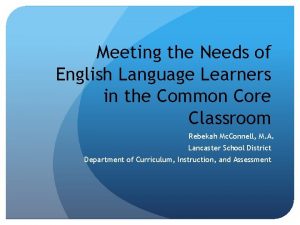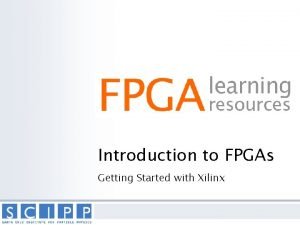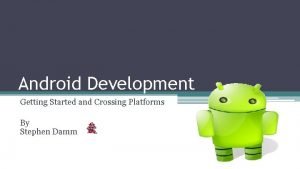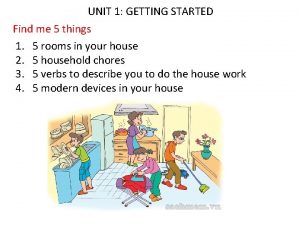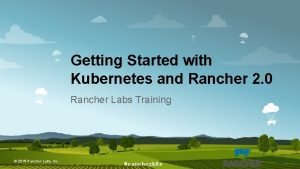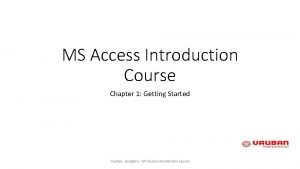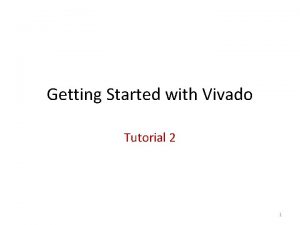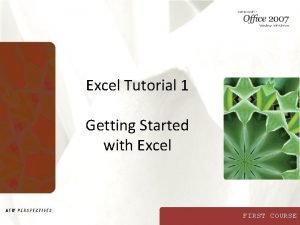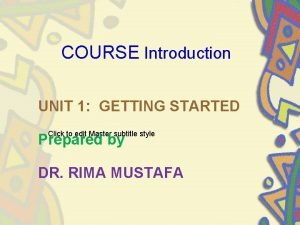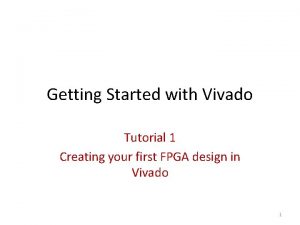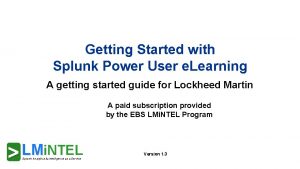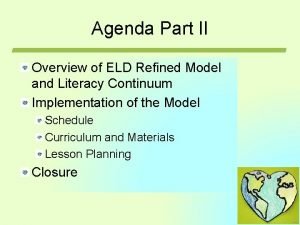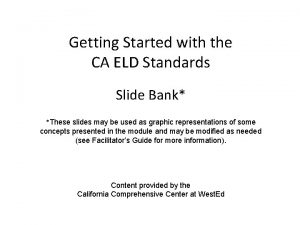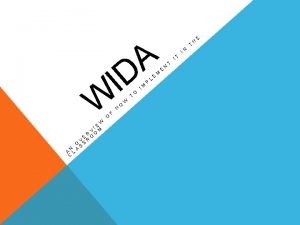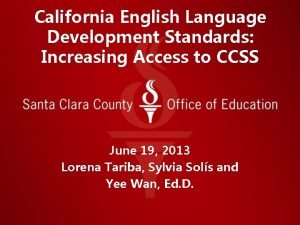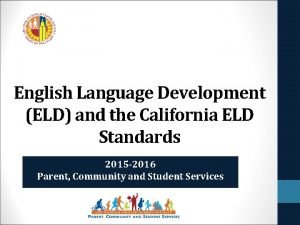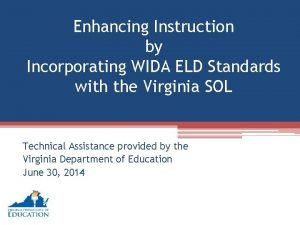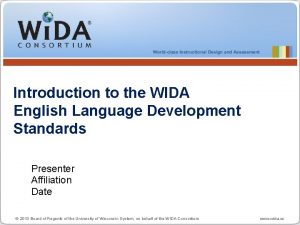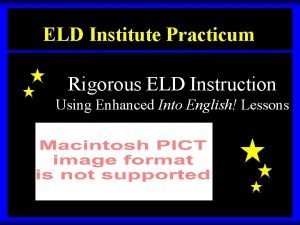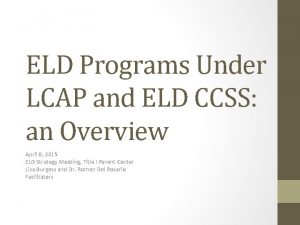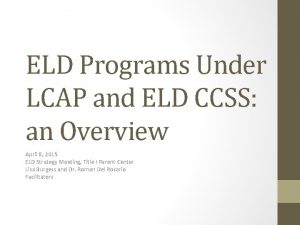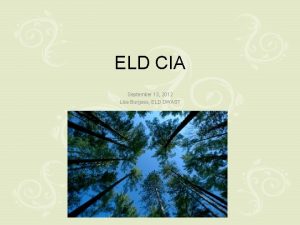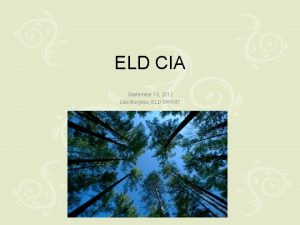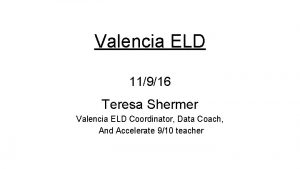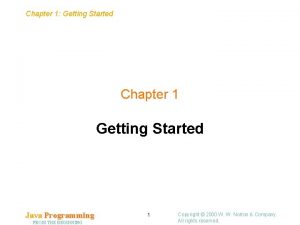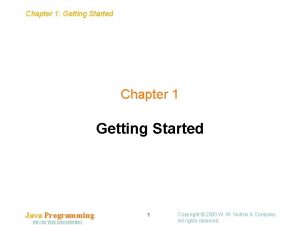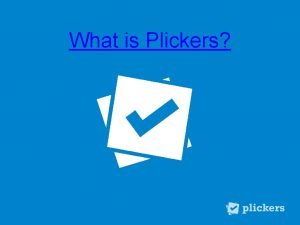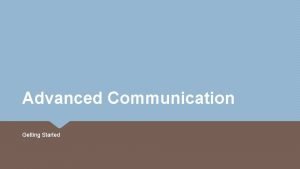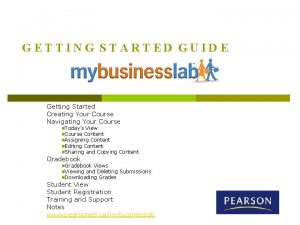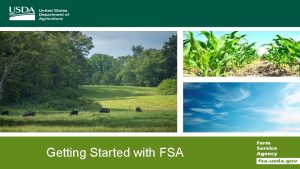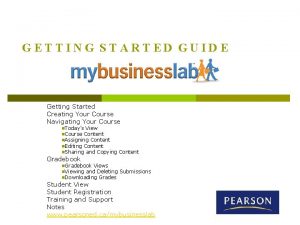Getting Started with the CA ELD Standards Slide






























- Slides: 30

Getting Started with the CA ELD Standards Slide Bank* *These slides may be used as graphic representations of some concepts presented in the module and may be modified as needed (see Facilitator’s Guide for more information). Content provided by the California Comprehensive Center at West. Ed

Some of the Big Pedagogical Shifts of the CA CCSS for ELA/Literacy 1. Close readings of complex informational and literary texts 2. 3. 4. s e n i l Taking a stand supporting it with evidence p i c s i d Engaging in collaborativeeconversations about h t s intellectually rich content s o r c A language and developing language Using academic awareness 5. Valuing multilingualism and cultural diversity

The CA ELD Standards AMPLIFY the CCSS for ELA/Literacy. Spycher, West. Ed (2013)

Key Shifts: 1999 to 2012 CA ELD Standards, Appendix B, CDE

CA ELD Standards: Elements Overview & Proficiency Level Descriptors (PLDs): ü Correspondences to the CA CCSS for ELA/Literacy ü CA’s EL Students ü Proficiency Level Descriptors (PLDs) ü Structure of the grade level standards Grade Level ELD Standards: ü Section 1: Goal, Critical Principles, At-a-glance Overview ü Section 2: Elaboration on Critical Principles • Part I: Interacting in Meaningful Ways • Part II: Learning About How English Works • Part III: Using Foundational Literacy Skills Appendices: ü Appendix A: ü Appendix B: ü Appendix C: ü Appendix D: Foundational Literacy Skills Learning About How English Works Theory and Research Context, Development, Validation Glossary of Key Terms

Three English Language Proficiency Levels Native Language: Students come to school with a wide range of home language resources to be tapped. Emerging Expanding Bridging Lifelong Language Learning: Students who reach proficiency in English must continue to build breadth, depth, and complexity in comprehending and communicating in English in a wide variety of contexts.

The CA ELD Standards: Structure Section 1: Section 2: 2 -page “Goals, Critical Principles, Grade level standards by proficiency levels and “At a Glance” overview

Section 1: Goals, Critical Principles, and “At-a. Glance” Overview Goal we have for our EL students in CA Critical Principles for carrying out the goal Correspondences to the CA CCSS for ELA/Literacy

Section 2: Grade Level ELD Standards by Proficiency Levels Part I: Interacting in Meaningful Ways Part III: Foundational Literacy Skills Part II: Learning About How English Works

ELD Standards: The Left Hand Column Signals that language development occurs in the context of using a variety of texts and engaging in meaningful discourse Shows the “many-to-many” correspondences between the CA CCSS for ELA/Literacy and the CA ELD Standards Related to how we make language choices depending on: • Our purpose for using language • The text types we’re using (both oral and written) and how they’re structured • The relationship between the people using the language

Numbering of the CA ELD Standards

CA ELD Standards Appendices: Resources to Support Implementation Appendices: ü Appendix A: ü Appendix B: ü Appendix C: ü Appendix D: Foundational Literacy Skills Learning About How English Works Theory and Research Context, Development, Validation

Part III: Using Foundational Literacy Skills

Appendix A: Foundational Literacy Skills Instruction for English Learners in K-12 14

Appendix B: Part II: Learning About How English Works Ø Provides guidance on how to apply Part II of the standards in tandem with Part I Ø Discusses some of the language demands of the CA CCSS for ELA/Literacy Ø Shows differences between everyday and academic English Ø Provides practical ideas and instructional strategies 15

Appendix B: Part II: Learning About How English Works 16

Appendix C: Theoretical Foundations and Research Base Theories and research discussed in sections: • • • 17 Interacting in Meaningful and Intellectually Challenging Ways Scaffolding Developing Academic English The Importance of Vocabulary The Importance of Grammatical and Discourse. Level Understandings Other Relevant Guidance Documents

Appendix C: Theoretical Foundations and Research Base 18

Glossary: Your Secret Source of Knowledge about Language! Provides definitions, explanations, and examples of key terms in the ELD Standards and the CCSS for ELA/Literacy.

Integrated & Designated ELD Both/And Integrated ELD: All teachers with ELs in their classrooms use the CA ELD Standards in tandem with the focal CA CCSS for ELA/Literacy and other content standards. Designated ELD: A protected time during the regular school day when teachers use the CA ELD Standards as the focal standards in ways that build into and from content instruction in order to develop critical language ELs need for content learning in English.

Comprehensive ELD Instruction: Three Interrelated Areas From the draft CA ELA/ELD Framework for review by the IQC November 2013 Based on • Halliday, 1978 • Gibbons, 2002 • Schleppegrell, 2004 Learning to use English Language Development Learning content through English Learning about how English works

What are the Proficiency Level Descriptors?

Turn to pages 8 and 9 of your print-out.

A Continuum of English Language Development Across Three Levels Native Language Emerging Expanding Bridging Lifelong Language Learning

High Level Thinking with Linguistic Support Emerging • Substantial Support Expanding • Moderate Support Bridging • Light Support Lifelong Language Learning • Occasional Support

Turn to pages 10 and 11 of your print-out.

Progression of Language Development in Three Modes of Communication Collaborative • Engagement in dialogue with others Interpretive • Comprehension and analysis of written and spoken texts Productive • Creation of oral presentations and written texts

Turn to pages 12 and 13 of your print-out.

Progression of Knowledge of Language in Two Dimensions Metalinguistic Awareness • Language awareness and selfmonitoring Accuracy of Production • Increasing accuracy with variation depending on context

Purpose of the Proficiency Level Descriptors • Describe what ELs know and can do • Present a continuum of knowledge, skills, and abilities • Guide targeted instruction in ELD • Inform local and state assessment
 Getting ahead
Getting ahead Integrated eld vs designated eld
Integrated eld vs designated eld Getting started with xilinx fpga
Getting started with xilinx fpga Android development getting started
Android development getting started Find these things in unit 1
Find these things in unit 1 Rancher get started
Rancher get started Unit 3 getting started
Unit 3 getting started Lua getting started
Lua getting started Tipos de habilidades del pensamiento
Tipos de habilidades del pensamiento Getting started with vivado
Getting started with vivado Linkedin getting started
Linkedin getting started Getting started with excel
Getting started with excel Unit 1 getting started
Unit 1 getting started When does elena receive dolls from her family members
When does elena receive dolls from her family members Getting started with eclipse
Getting started with eclipse Unix for bioinformatics
Unix for bioinformatics Perl read_file
Perl read_file Getting started with vivado
Getting started with vivado Getting started with microsoft outlook learning
Getting started with microsoft outlook learning Getting started with poll everywhere
Getting started with poll everywhere Unit 1 getting started
Unit 1 getting started Mathematica getting started
Mathematica getting started Education.splunk.com
Education.splunk.com Getting started with ft8
Getting started with ft8 Az elp standards
Az elp standards Ca eld standards
Ca eld standards Wida eld standards
Wida eld standards Ca eld standards
Ca eld standards Emerging expanding and bridging
Emerging expanding and bridging Wida eld standards
Wida eld standards Wida levels 1-6
Wida levels 1-6

